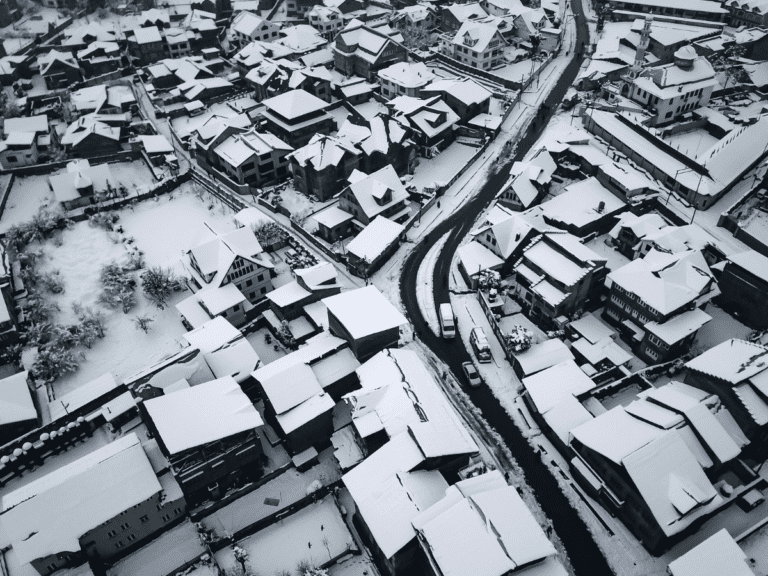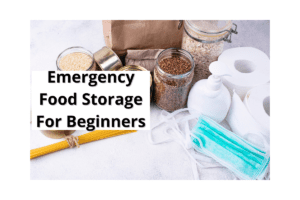Have you ever found yourself in the dark, shivering, and wishing you’d been better prepared for a winter power outage? You’re not alone. Winter power outages can severely impact our comfort, safety, and even our survival. As someone interested in prepping, you know just how crucial it is to plan ahead.
In this post, I’ll walk you through the key steps to ensure your home is ready for whatever harsh winter throws your way. From stocking up on essential supplies to safeguarding your heating systems, I’ve got the advice you need to stay warm and safe. Don’t wait until the first snowstorm hits—let’s get prepared together.


Post Contents
ToggleUnderstanding Winter Power Outages
Winter power outages can strike unexpectedly, leaving us without light, heat, and communication. It’s important to understand why these outages happen and how they can impact our daily lives. Let’s dive into the common causes and the potential duration and impact of these power failures.
Common Causes
Winter power outages are often triggered by severe weather conditions. Here are some of the most common causes:
Severe Snowstorms: Heavy snowfall can weigh down trees, causing branches to snap and fall onto power lines. This can disrupt the electricity supply to entire neighborhoods.
Ice Accumulation: Ice storms coat power lines, trees, and other structures with a thick layer of ice. The added weight can cause power lines to break and trees to fall, leading to widespread outages. According to Ready.gov, ice can add as much as 30 to 40 times more weight on power lines and trees compared to snow.
High Winds: Strong winter winds can knock down trees and power poles. They can also damage electrical equipment, resulting in power outages. We often see this during intense winter storms or blizzards.
Infrastructure Failures: Aging or poorly maintained infrastructure can fail under the stress of winter conditions. When transformers, power lines, and substations are not up to par, they’re more likely to break down during a storm.
To stay informed about potential risks and regional concerns, it’s a good idea to regularly check updates from sources like the National Weather Service.
Duration and Impact
The duration of winter power outages can vary widely. In some cases, power may be restored within a few hours. However, severe storms can lead to outages lasting several days or even weeks in extreme cases.
Impact on Daily Life:
- Heating: Without electricity, your heating system may shut down. This is especially dangerous in freezing temperatures, and it’s why having alternative heating sources, like wood stoves or portable heaters, is crucial.
- Cooking: Electric stoves and microwaves won’t work during an outage. Having a backup plan, such as a gas stove, propane grill, or even a camping stove, can ensure you can still prepare meals.
- Communication: Keeping charged cell phones, radios, or having a battery backup is vital. Power outages can knock out internet and cable services, making it harder to stay informed about weather updates or emergency instructions.
In a recent National Grid report, it was noted that over 20% of winter outages are prolonged beyond 24 hours, significantly disrupting daily routines.
Understanding these aspects of winter power outages helps us better prepare our homes. Knowledge is power, and in this case, it can keep you warm and safe through the harshest winters.
Essential Supplies for Winter Power Outages
When winter power outages hit, having the right supplies ready can make all the difference. From food and heating to lighting and medical needs, here’s what you’ll need to stay safe and comfortable.
Food and Water
During a winter power outage, it’s crucial to have enough food and water to last a few days. Here are some smart choices:
- Non-Perishable Food Items: Stock up on canned goods, dried fruits, nuts, granola bars, and instant noodles. These items require no refrigeration and can be eaten cold if necessary.
- Water Storage: Have at least one gallon of water per person per day for drinking and basic needs. Store water bottles or large water containers in a cool, dark place.
- Safe Food Preparation: If you can’t use your electric stove, a camping stove or a propane grill can be lifesavers. Just make sure to use them outside or in a well-ventilated area to avoid carbon monoxide build up.
Having a stash of non-perishables and a plan for food prep without power ensures you won’t go hungry during an outage.
Heating Solutions
Keeping warm without electricity can be a challenge. Here are some backup heating solutions:
- Space Heaters: Battery-operated or propane-powered space heaters provide a portable heating option. Ensure you follow safety guidelines and have proper ventilation.
- Wood Stoves: A wood stove can be a reliable source of heat. Keep a stockpile of dry firewood and kindling.
- Extra Blankets: Simple but effective, having plenty of thick blankets and sleeping bags can help retain body heat. Consider thermal blankets, which are designed to reflect body heat.
Staying warm is essential to prevent hypothermia, so preparing these heating solutions is critical.
Lighting and Power
Keeping your home lit and devices powered up is also important:
- Battery-Operated Lights: Headlamps, lanterns, and LED lights are great for brightening up your space. Keep extra batteries on hand.
- Flashlights: Flashlights are a staple. Have a few in key locations around your home for quick access.
- Portable Generators: If you rely on power for essential medical devices, a portable generator can be a game-changer. Ensure you operate it safely outside to avoid carbon monoxide poisoning.
- Conserving Battery Life: Turn off devices when not in use, dim screen brightness, and unplug chargers to make your battery-operated devices last as long as possible.
With these solutions, you can keep the lights on and stay connected even when the power is out.
Medical and First Aid Supplies
Health and safety come first, especially during emergencies. Here’s what to keep in stock:
- First Aid Kit: A well-stocked first aid kit is a must. Include bandages, antiseptic wipes, gauze, scissors, tweezers, and pain relievers.
- Medications: Ensure you have a supply of all essential medications you or your family members need. Store them in a cool, dry place that’s easy to access.
- Medical Supplies: If you or a family member uses medical devices that require power, have a plan for battery backups or alternative power sources.
Having these medical supplies ready can help you manage minor injuries and health conditions during an outage.
With these essential supplies, you’ll be well-prepared for winter power outages. Whether it’s staying warm, keeping fed, or managing medical needs, taking these steps now can ensure your comfort and safety when the lights go out.
Preparing Your Home for Winter Power Outages
When a winter power outage strikes, being unprepared can turn a cozy evening into a chilling nightmare. We can’t stop the weather, but we can take steps to make sure our homes are ready. Let’s take a look at some practical methods to keep your home warm and your family safe.
Insulating Your Home
Keeping the cold out and the heat in is the name of the game. Here are some effective ways to improve your home’s insulation:
Seal Windows and Doors: Use caulk and weather stripping to seal gaps around windows and doors. Cold air can sneak in through these tiny cracks, making it harder to keep your home warm.
Add Weather Stripping: Weather stripping around doors and windows adds an extra layer of protection. This simple addition can significantly reduce drafts and save on heating costs.
Install Door Sweeps: A door sweep at the bottom of exterior doors can prevent cold air from entering your home. They are easy to install and can make a big difference in keeping your home insulated.
By taking these steps, you can keep your home warmer and your heating system from working overtime.
Protecting Plumbing
Frozen pipes are a nightmare during a winter power outage. Here’s how to keep your pipes from freezing:
Insulate Pipes: Wrap pipes in insulation foam or use heat tape, especially those in unheated areas like basements, attics, and garages. This can prevent the pipes from freezing and bursting.
Allow Faucets to Drip: Letting faucets drip slightly can prevent water from freezing inside the pipes. The flowing water helps reduce pressure and keeps the pipes from bursting.
Keep Cabinet Doors Open: If your kitchen or bathroom pipes are on an exterior wall, open the cabinet doors to let warm air circulate around the pipes.
Taking these precautions can save you from costly repairs and the hassle of dealing with frozen pipes.
Emergency Communication Plans
Staying connected during a power outage is crucial. Here are some ways to maintain communication:
Battery-Powered Radios: Keep a battery-powered or hand-crank radio to stay updated on weather alerts and news. This is a reliable source of information when other communications fail.
Family Communication Plan: Have a plan in place to reach family members during an outage. This can include a designated meeting spot or a way to check-in with each other regularly.
Backup Power for Phones: Invest in portable chargers or power banks to keep your cell phones charged. Without electricity, these devices are essential for communication and accessing information.
By setting up these communication methods, you can ensure that your family stays connected and informed during a power outage.
Staying Safe and Warm During an Outage
When winter power outages leave us shivering and in the dark, staying safe and warm becomes our top priority. Let’s explore some essential tips to help you maintain comfort and safety during these challenging times.
Layering Clothing
Wearing multiple layers of clothing is one of the simplest and most effective ways to retain body heat during a power outage. Think of each layer as a building block in your personal “heat trap.”
- Base Layer: Start with a moisture-wicking fabric next to your skin to keep sweat away. Materials like merino wool or synthetic fabrics work best.
- Middle Layer: Add insulation with materials like fleece or down. This layer traps heat close to your body.
- Outer Layer: Finish with a windproof and waterproof jacket to block out cold air and moisture.
Layering clothes not only keeps you warmer but also allows you to adjust easily based on your activity level and indoor temperature.
Using Alternative Heat Sources Safely
When the power goes out, having alternative heat sources can be a lifesaver. However, safety is paramount. Here are some precautions to take when using fireplaces, space heaters, and other heating methods:
Fireplaces: Ensure your fireplace is clean and well-maintained. Keep a glass or metal screen in front of it to prevent sparks from escaping. Always have a fire extinguisher nearby.
Space Heaters: Space heaters should be placed on a flat, stable surface at least three feet away from curtains, furniture, and other flammable items. Opt for heaters with automatic shut-off features in case they tip over. Energy.gov has more great tips on selecting and using space heaters safely.
Wood Stoves: If you have a wood stove, make sure the flue is open to let the smoke escape outside. Keep a stockpile of dry wood and be mindful of creosote build up, which can cause chimney fires.
Safety checks and proper usage of these heat sources can keep your home warm without introducing fire hazards or carbon monoxide risks.
Maintaining Indoor Air Quality
Using alternative heat sources can sometimes affect the air quality in your home. Here’s how to ensure you and your family breathe safely:
Ventilation: Always use adequate ventilation when burning wood, gas, or using a generator. Open a window slightly to let fresh air in and prevent carbon monoxide build up.
Carbon Monoxide Detector: Install battery-operated or battery-backed-up CO detectors on every level of your home, especially near sleeping areas. According to the CDC, CO2 poisoning is a serious risk during power outages when alternative heating is used.
Proper Generator Use: Generators should never be used indoors or in an enclosed area like a garage. Keep them at least 20 feet away from windows, doors, and vents.
These steps will help keep the air in your home clean and reduce the risk of carbon monoxide poisoning.
By following these tips, you can ensure that you and your loved ones stay safe and warm during winter power outages. Layer up, use alternative heat sources wisely, and keep your indoor air quality in check for a safe and cosy home environment.


Long-term Power Outage Scenarios
Winter power outages can extend beyond just a few hours or days, leading to more severe challenges. Preparing for these long-term scenarios is crucial for ensuring the safety and well-being of your household. Let’s explore some effective strategies for handling extended outages.
Sustainable Food and Water Supplies
When faced with a long-term power outage, having sustainable food and water supplies is essential. Here are some practical solutions:
Long-term Food Storage
- Canned Foods: Stock up on canned vegetables, beans, and soups. These have long shelf lives and don’t require refrigeration. Rotate your stock regularly to keep it fresh.
- Dehydrated and Freeze-Dried Foods: These options are lightweight and have a long shelf life. Brands like Mountain House offer a variety of meal choices, including breakfast, lunch, and dinner packs.
- Bulk Staples: Store dry goods like rice, pasta, oats, and beans in airtight containers. These items are versatile and can be used in a variety of recipes.
- Home Canning: If you garden or buy in bulk, consider home canning fruits, vegetables, and meats. This method preserves food for months, allowing you to make the most of seasonal produce.
Maintaining a well-rounded stock of non-perishable foods ensures you have nutritious options that can sustain you through an extended outage.
Sustainable Water Sources
- Rainwater Collection: Setting up a rainwater harvesting system is a smart way to ensure you have a sustainable water source. Rain barrels can be installed under gutter downspouts to collect and store water. Make sure the collected water is filtered and purified before use.
- Water Filtration Systems: Invest in high-quality water filters like the Berkefeld These systems can purify rainwater, river water, or even tap water to make it safe for drinking.
- Water Storage: Keep a supply of bottled water or large water storage containers. Aim for at least one gallon per person per day. Rotate your stock to keep it fresh.
By investing in sustainable food and water supplies, you can be more self-sufficient and resilient during prolonged outages.
Community Support
In times of extended power outages, community cooperation and resource sharing become invaluable. Here’s how building a supportive community can make a difference:
Forming a Community Network
- Neighbourhood Groups: Establish a neighbourhood preparedness group where you can share resources, knowledge, and support. Platforms like Nextdoor can help you connect with your neighbours effectively.
- Skill Sharing: Identify and utilize the skills within your community. Some neighbours might have expertise in areas like medical care, plumbing, or carpentry, which can be beneficial during prolonged outages.
- Resource Pooling: Share resources such as generators, cooking equipment, and heating supplies. This collaborative approach ensures that everyone has access to what they need.
Organized Efforts
- Local Shelters: Identify local community centres or shelters that can provide warmth, food, and power. Volunteering at these centres can help them run more efficiently and benefit everyone involved.
- Communication Plans: Establish an emergency communication plan with your neighbours. Use walkie-talkies or CB radios to stay in touch when phone networks are down.
- Emergency Drills: Conduct regular emergency drills with your community to ensure everyone knows what to do in various scenarios. This preparation can mean the difference between chaos and coordinated effort.
Forming strong community ties and organizing support networks can greatly enhance your ability to cope with long-term power outages. By coming together, we can share resources, expertise, and moral support, making these difficult times more manageable for everyone.
Conclusion
Winter power outages are a reality we need to be ready for. From understanding the common causes to stocking up on essential supplies and safeguarding our homes, being prepared can make all the difference.
Insulating your home, protecting your plumbing, and having a solid communication plan can ensure your family’s safety when the power goes out.
Don’t wait until the lights go out to start preparing. Take action today to make sure you’re ready for the worst winter can throw at you. Your comfort, safety, and peace of mind are worth the effort.















